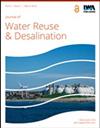酸活化膨润土与蔗渣灰混合作为低成本吸附剂去除活性红198染料
IF 2.3
Q2 Environmental Science
引用次数: 6
摘要
研究了酸活化膨润土与甘蔗渣(SCBA)吸附剂混合对合成染料溶液中活性红198 (RR198)的去除效果。考察了膨润土的吸附参数对SCBA掺比、染料溶液pH、吸附接触、吸附剂用量和初始染料浓度的影响,并优化了吸附参数,以最大限度地去除合成染料溶液中的RR198。在膨润土与SCBA配比为1:1、溶液pH为2、吸附剂用量为3.7 g/L、初始染料浓度为15 mg/L、吸附时间为150 min的最佳条件下,考察了吸附剂的比表面积、晶相结构、官能团和表面形貌等性能。在最佳条件下,吸附剂的RR198去除率达到97%。为了确定吸附动力学和等温线模型,采用了不同的吸附模型。结果表明,含SCBA吸附剂的酸活化膨润土对RR198染料的吸附符合Langmuir等温线模型,吸附动力学为准二级。本文章由计算机程序翻译,如有差异,请以英文原文为准。
Acid-activated bentonite blended with sugarcane bagasse ash as low-cost adsorbents for removal of reactive red 198 dyes
The present research work investigated the removal efficiency of acid-activated bentonite blended with a sugarcane bagasse ash (SCBA) adsorbent for the removal of reactive red 198 (RR198) from a synthetic dye solution. The effect of the adsorption parameters of bentonite on SCBA blending ratio, dye solution pH, adsorption contact, adsorbent dosage, and initial dye concentration was investigated, and the parameters were optimized for maximum RR198 removal from the synthetic dye solution. At an optimum condition of 1:1 bentonite to the SCBA blending ratio, a solution pH of 2, 3.7 g/L of adsorbent dosage, and 15 mg/L of initial dye concentration 150 min of adsorption time, the properties of adsorbents such as adsorbent specific surface area, crystalline phase structure, functional groups, and surface morphologies of the adsorbents were investigated. At optimum conditions, 97% RR198 removal efficiency of the adsorbent was achieved. In order to determine adsorption kinetics and isotherm models, different adsorption models were employed. It was observed that the adsorption of the RR198 dye into the acid-activated bentonite blended with the SCBA adsorbent was represented well by the Langmuir isotherm model and the adsorption kinetics order was found to be the pseudo-second order.
求助全文
通过发布文献求助,成功后即可免费获取论文全文。
去求助
来源期刊

Journal of Water Reuse and Desalination
ENGINEERING, ENVIRONMENTAL-WATER RESOURCES
CiteScore
4.30
自引率
0.00%
发文量
23
审稿时长
16 weeks
期刊介绍:
Journal of Water Reuse and Desalination publishes refereed review articles, theoretical and experimental research papers, new findings and issues of unplanned and planned reuse. The journal welcomes contributions from developing and developed countries.
 求助内容:
求助内容: 应助结果提醒方式:
应助结果提醒方式:


